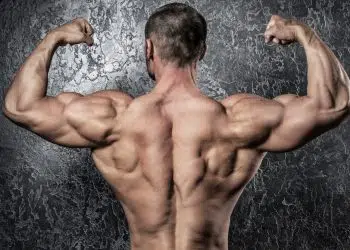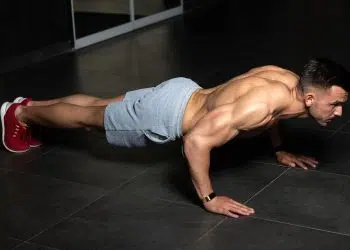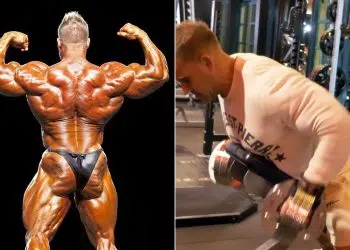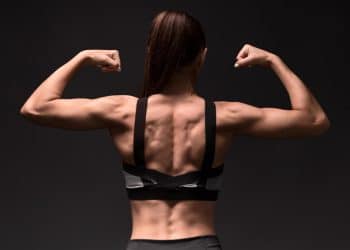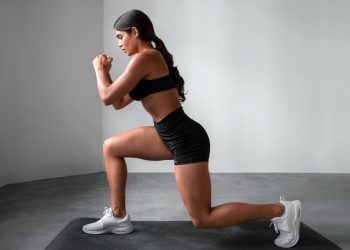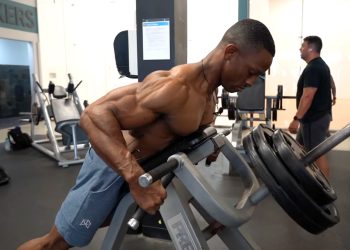Not everyone has access to a gym or fitness equipment or maybe you just prefer to incorporate bodyweight exercises regardless. Well, you know we always got your back… literally!
Now, the upper posterior chain (backside of the body) is one group of muscles that can be hard to find bodyweight exercises for. Sure, you have pullups and chin-ups but we all know you need more variety to get maximum results.
But don’t fret… there are several phenomenal options that require little to no equipment.
13 Bodyweight Exercises to Build Your Back
We’ve got 13 top bodyweight back exercises you should be doing for a yoked posterior.
- Inverted row
- Lying Back Press
- Pull-up/Chin-up
- Reverse Fly
- TRX Row
- Reverse Plank (Modified)
- Y Raise
- Elbow Lifts/Bridge
- Superman
- Superman W/ External Rotation
- Reverse Push-up
- T Pushup
- Bodyweight bridge
1. Inverted row
An extremely underrated back exercise, the inverted row is an amazing posterior chain movement. But research shows that it’s a superior exercise for the middle trapezius muscle especially. Plus, you don’t have to hang your entire body weight from the bar which makes it much easier than a conventional pull-up or chin-up.
How to Do It:
- Setup the Smith machine bar to a decent height that allows you to get underneath it and hang so your arms are fully extended with your heels on the floor.
- Sit under the bar and grip it a little wider than shoulder-width.
- Extend your legs out in front of you and pull yourself up to the bar so that it touches your lower chest.
- Reverse the motion and repeat.
Tips:
- Once you’re a little more advanced, elevate your feet onto a bench to increase the level of difficulty.
- You can also try doing it using one arm at a time for even more benefit. Plus it’s great for training unilateral (affecting one side) function and identifying strength imbalances.
2. Lying Back Press
The Lying Back Press is effective exercise that you can do anywhere without any equipment! In this move you’re using the strength of your back muscles, especially around your shoulder blades, to give your upper back a solid workout.
Level Up Your Fitness: Join our 💪 strong community in Fitness Volt Newsletter. Get daily inspiration, expert-backed workouts, nutrition tips, the latest in strength sports, and the support you need to reach your goals. Subscribe for free!
This is a simple exercise, but trust me, you’ll feel it! You start by lying flat on your back, tensing up your core, and then using your arms to lift your upper body. The Lying Back Press can find a place in your workout routine. Just take it slow and steady, and you’ll be feeling stronger in no time!
How to Do It:
- Begin by lying down on your back, your knees should be bent, and arms extended out on both sides of your body.
- Engage, or squeeze, your glutes (the muscles in your buttocks) and your abdominal muscles to create tension in your body.
- Press your forearms and elbows into the floor to lift, or elevate, your back. Ensure that your neck stays relaxed and in a neutral position, avoid straining it as you lift your back.
- Maintain this elevated position for a count of 2 to 3 seconds. During this time, keep your upper back muscles and your core (abdominal muscles) engaged.
- Lower your back down slowly to return to your starting position.
Remember, the aim is to have slow, controlled movements throughout this exercise to fully engage the intended muscle groups and to avoid injury
Tips:
- Stay focused on your form to ensure effectiveness and avoid injury.
- Perform slow, controlled movements.
- Engage your core throughout the exercise.
- Breathe properly – exhale when lifting, inhale when lowering.
- Keep your neck relaxed and neutral.
3. Pull-Up/Chin-Up
You simply cannot have a list of best bodyweight back exercises without the pull-up/chin-up. In fact, most people would probably agree that both variations (pull-up/chin-up) are superior to all other bodyweight back movements. And if you’re not yet convinced, the pull-up and chin-up have shown to elicit better lat activation than other common back exercises (e.g. bent-over row, inverted row, lat pull-down, and seated row). (1)
How to Do It:
Pull-up
- Use an overhand, slightly wider than shoulder-width grip.
- Depress and retract your shoulder blades.
- Keep your legs straight and together positioned slightly in front of you.
- Pull yourself all the way up to the bar and squeeze your back muscles.
- Lower yourself back down but don’t allow your head to sink down into your shoulders. Maintain a retracted scapula.
- Repeat
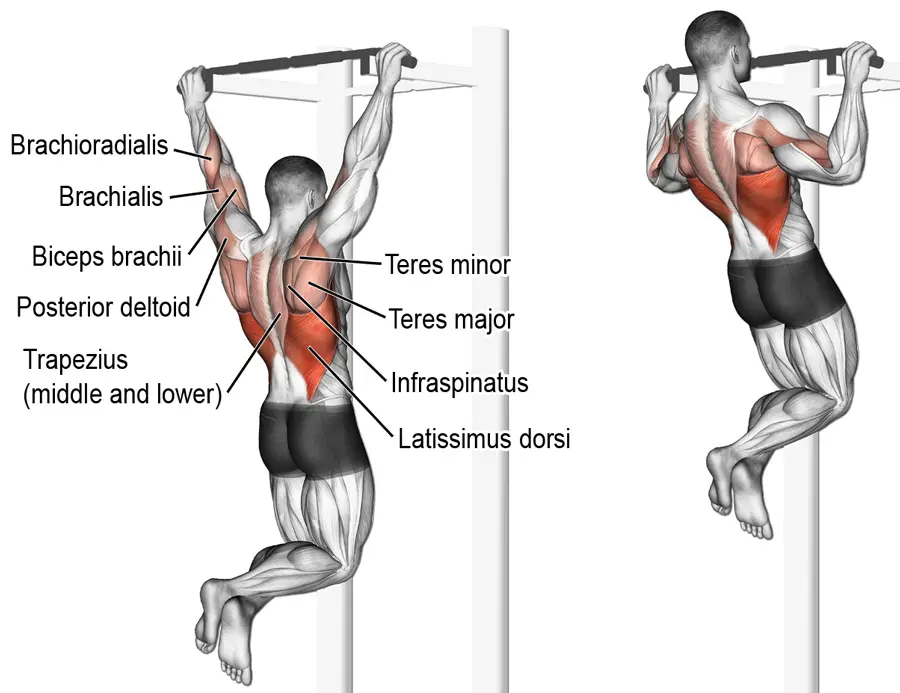
Chin-up
- Use an underhand, shoulder-width or slightly closer grip.
- Depress and retract your shoulder blades.
- Keep your legs straight and hold them slightly in front of you.
- Pull yourself up to the bar then slowly lower yourself down maintaining proper posture as explained with the pull-up.
- Repeat
Check out these top pull-up bars currently on the market!
4. Reverse Fly
The Reverse Fly is a great simple yet profoundly effective exercise that targets your upper body, focusing especially on your shoulders and upper back. This exercise shines in its ability to build and strengthen the rear deltoids, the muscles at the back of your shoulders. It’s a staple in many workout routines because of its effectiveness in improving muscle strength, enhancing posture, and contributing to a well-rounded shoulder workout.
What makes the Reverse Fly stand out is its emphasis on the mind-muscle connection. It’s not just about going through the motions, but really feeling and focusing on the muscles you’re working. The exercise encourages you to be present and aware, making each rep more effective and leading to noticeable improvements over time.
How to Do It:
- Stand with your feet shoulder-width apart.
- Hinge at the hips and lean forward, maintaining a slight bend in your knees and a flat back. Let your arms hang straight down.
- Rotate your arms so your palms face forward and your thumbs are pointing up.
- Squeeze your shoulder blades together and raise both arms straight back in a fly motion. Make sure to squeeze your rear deltoids and pause briefly at the top.
- Gradually reverse the movement to bring your arms back down.
Tips:
- Maintain a slow, controlled motion throughout the exercise.
- Focus on the mind-muscle connection; really feel your shoulder and back muscles working.
- Keep your back flat and avoid arching your spine.
- Don’t rush the pause at the top; this squeeze helps target your muscles more effectively.
- Avoid using momentum to raise your arms; rely on your muscle strength.
- Be consistent, improvements come with regular practice.
5. TRX Row
Suspension training is an awesome alternative to other forms of resistance training. Well, the TRX system is very popular because you can do essentially any exercise and all you need is an anchor. It’s a great tool for back training because you can do rows, pull-ups, and anything else you can think of.
How to Do It:
- Using one or two hands, grip the handle/s and allow yourself to lean back to where you’re holding up your bodyweight.
- Pull yourself toward the straps and squeeze your back muscles at the top.
- Reverse the motion then complete desired reps and switch arms if doing one arm at a time.
Here’s a video example of the TRX row…
6. Reverse Plank (Modified)
The reverse plank is an incredible isometric exercise that is more challenging than the traditional plank. As a result, you’ll benefit much more as the posterior chain is typically a weaker area for many people.
And with the reverse plank, your back is more involved in maintaining a rigid position especially in how it’s performed. It’s excellent for working the upper back muscles and the rotator cuff, plus, it’ll work the core muscles too.
So, instead of holding yourself up by your forearms and placing the ball of your feet on the floor, you’d be lying on your back with your arms extended out to form a cross with your body.
How to Do It:
- Lie on your back
- Externally rotate your forearm so that your palms are facing up (this activates the back muscles) and place your arms out to your sides to form a cross with your body.
- Squeeze your shoulder blades together.
- Lift your hips up as high as you can and hold this position for as long as you can.
- The lower back down and repeat.
Tip: Elevate your upper back onto something to make the movement easier which is ideal for beginners or those without sufficient strength.
7. Y Raise
The Y Raise is a low-impact movement, all about precision and connection. It offers an excellent way to strengthen your shoulder muscles, focusing on the upper part of your trapezius, which are the muscles at the back of your neck and shoulders. It’s not just about gaining strength, but also about understanding and enhancing the mind-muscle connection, which means you’ll be focusing on the squeeze of your shoulders and maintaining a strong, stable posture throughout the movement.
How to Do It:
- Stand with your feet shoulder-width apart.
- Hinge at your hips and lean forward, keeping a slight bend in your knees and maintaining a flat back. Let your arms hang straight down.
- Position your hands in a neutral position, palms facing each other, with thumbs pointing upwards.
- Squeeze your shoulders and raise your arms straight out in front of you to form a ‘Y’ shape.
- Pause at the top for a moment, continuing to squeeze your shoulders.
- Lower your arms back to the starting position.
Tips:
- Maintain controlled movements throughout the exercise.
- Focus on the mind-muscle connection and squeeze your shoulders during each raise.
- Maintain a flat back and good posture throughout the movement.
- Pause and squeeze at the top of each raise to maximize muscle engagement.
- Avoid swinging your arms, ensure the movement is controlled and driven by your muscles.
8. Elbow Lifts/Bridge
One of the best and simplest bodyweight exercises available, elbow lifts or elbow bridges work mainly the upper back (rhomboids, traps) but it also activates the lats, traps, and reverse delts. You need no equipment and can do this anywhere.
You can also use a cushioned surface to prevent discomfort in your elbows.
Level Up Your Fitness: Join our 💪 strong community in Fitness Volt Newsletter. Get daily inspiration, expert-backed workouts, nutrition tips, the latest in strength sports, and the support you need to reach your goals. Subscribe for free!
How to Do It:
- Lie on your back with your legs either straight out or bent and place your arms by your sides.
- Bend your elbows so your fists are pointed toward the ceiling.
- Drive your elbows through the floor and squeeze your shoulder blades together so that your torso lifts off the floor.
- Hold this position for 2-3 seconds.
- Repeat
Here’s a video example…
9. Superman
This is a great lower and upper back/traps exercise that you can do with just your bodyweight. Now, you’ll need to have decent mobility and strength in your entire posterior. But most healthy people should be able to hold in the required position.
There are also so many different useful variations for the Superman that you can do to increase the difficulty level and/or work more muscles of the back overall.
How to Do It:
- Lie face down and place your arms out in front of you.
- Lift your torso and legs up at the same time so that your position resembles that of Superman.
- Hold for 2-3 seconds.
- Lower back down and repeat.
10. Superman W/ External Rotation
This is a variation of the basic Superman exercise. But it involves external rotation of the arms to activate more of the posterior chain through scapular adduction. You’re working the lats, Erector Spinae, traps, and rhomboids with this movement.
How to Do It:
- Lie face down as you would the basic Superman exercise but place your arms down at your sides rather than out in front of you so your knuckles are on the floor.
- Lift your legs and torso up as you would the basic Superman but retract your shoulder blades and rotate your arms toward the center of your back so that your palms are facing the floor.
- Hold for 2-3 seconds
- Lower back down and repeat
11. Reverse Push-Up
What’s great about the reverse push-up is that you can do it at home using two chairs. Not to mention, it’ll allow you to get a decent range of motion and you’re still using your own bodyweight. Therefore, you can actually build some muscle and strength with this exercise. The reverse push-up is great for working the mid and upper back.
Now, it’d be ideal to use two benches for this as the padding is more comfortable and it’s more stable but chairs that have cushion can work too. Just find a spot that allows the chair to be secured for your safety (e.g. against a wall, on carpet, etc).
How to Do It:
- Set up two chairs or benches close enough to where you can place the back of your arms (triceps) on them.
- Sit on the floor and place your arms on the surface to get into position.
- Now, with your knees straight or bent, drive your elbows down and through to lift your body up and squeeze your back muscles.
- Hold for 2 seconds.
- Repeat
Tip: Don’t allow your body to sink too far down during the negative portion of the rep.
Here’s a great video example of how it’s done…
12. T Pushup
The T Pushup exercise is an advanced variation of the classic push-up. T-Pushup combines the strength training benefits of a standard pushup with the added bonus of improving thoracic mobility. In other words, it’s a fantastic exercise to enhance your upper body strength and your body’s rotational capability. Your chest, arms, and shoulders get a good workout, while your thoracic spine, the area between your neck and abdomen, benefits from the rotational movement.
How to Do It:
- Start in a pushup or plank position, with your hands placed slightly wider than your chest. Engage your glutes and core to keep your spine straight.
- Bend your elbows to lower your chest to the ground, squeezing your back muscles at the bottom of the movement.
- Push up, and as you ascend, rotate one side of your body upward, lifting the same-side arm straight up with it.
- Pause at the top of the movement, holding the position briefly.
- Return to the starting position and repeat the movement on the other side.
Tips:
- Maintain a controlled, steady pace. Quality over quantity.
- Keep your core and glutes engaged throughout to support your spine.
- Avoid letting your hips sag or pike during the movement.
- Ensure you squeeze your back muscles as you lower yourself.
- Keep your movements fluid – the pushup and rotation should blend into one continuous movement.
13. Bodyweight bridge
The bodyweight or glute bridge as they call it is a good lower back and erector spinae exercise. It’s typically used to work the butt but the back is very much involved.
And like a few of the other exercises on our list, all you need for this movement is yourself…
How to Do It:
- Lie on your back, bend your knees, and place your arms down by your sides.
- Lift your butt off the ground until your body forms a straight line and hold for 2 seconds.
- Lower your body back down and repeat.
Tip: You can do this exercise using two or one leg.
Now let’s briefly go over the back anatomy…
Back Anatomy
The back consists of several muscles that work together so you can stand up straight, bend over and twist, plus elevation, depress, and rotate the shoulders. Let’s go over the anatomy so you can have an idea of what you’re working with.
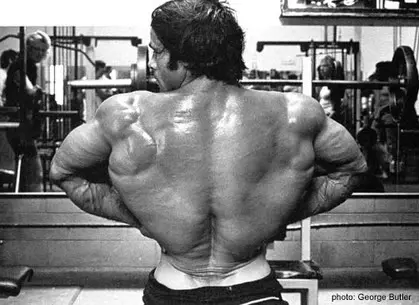
Rhomboids
The rhomboids are located below the trapezius on the upper back and are composed of a major and minor. It helps to form the shoulder girdle and plays a large role in upper limb function (e.g. retraction, elevation and rotation of the scapula).
Erector Spinae
The muscles (iliocostalis, longissimus, and spinalis) which make up the erector spinae run along either side of the spine. They run from the sacral region below the lower back to the base of the skull.
The erector spinae functions to extend, flex, and stabilize the vertebral column.
Levator scapulae
This muscle is found at the side and back of the neck. It functions to lift the scapula or shoulder blade.
Latissimus dorsi
The latissimus dorsi or lats is a very large and thin triangular-shaped muscle of the back that’s located on the majority of the lower posterior thorax. It works with the teres major and pectoralis major (chest muscle) to help extend, adduct, and medially rotate the arm. But it also interestingly functions as a respiratory accessory muscle.
The lats are highly engaged during pull-up movements.
Trapezius
The trapezius or traps for short is a large muscle that resembles a shape of the same name. It extends from the occipital bone on the neck down to the lower thoracic vertebrae and also spans laterally to the spine of the scapula.
This muscle stabilizes and moves the scapula or shoulder blade mainly for postural function. But since the traps have different fibers, each section functions to facilitate a different movement. The upper fibers function to assist in the elevation and upward rotation of the scapula, in addition to the extension of the neck. The middle fibers help retract the scapula. And the lower fibers depress and assist the upper fibers in upward rotation of the scapula.
Frequently Asked Questions
What are some effective bodyweight back exercises?
Some of the best bodyweight back exercises that target different muscles of the posterior chain include…
- Inverted row
- Pull-ups/chin-ups
- TRX row
- Reverse plank
- Elbow lift
- Superman
- Reverse push-up
- Bodyweight/glute bridge
Can you build a big, muscular back using bodyweight exercises?
Absolutely! If an exercise is challenging and allows for progressive overload (resistance or reps) then you can build muscle.
Many of the exercises on our list vary in difficulty but there are always ways to make them more challenging.
Is there one bodyweight exercise that's best for working all back muscles?
The simple answer to that is no. Like any large muscle group, you need a variety of movements for the back that target different areas for optimal development.
Wrapping Up
If you were looking for the best bodyweight exercises then you’ve come to the right place. The movements on our list are certainly not the only options. But they’re hard to beat when it comes to training with limited or no equipment.
Especially since the variety of exercises target different areas of the back which is ideal. So with that being said, include them in your back training routine for more growth and development.


